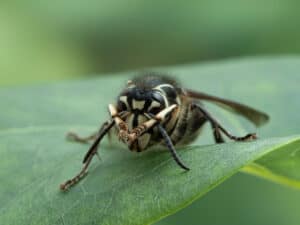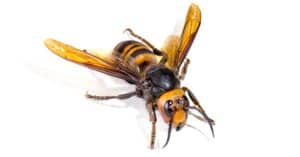The social insect known as the “paper wasp” constructs gray, paper-like nests in trees and other plants or beneath the eaves of houses, decks, and garages. Paper wasps are also referred to as “umbrella wasps,” and they get their moniker from the substances they use to construct their homes.
They come in 22 different species and have thin bodies with yellow patterns and black wings. Today we’re going to dive into everything paper wasps eat, along with some other interesting facts about their habits and environment!
Where Do Paper Wasps Live?
Using wood fiber gathered from plants, paper wasps create nests that resemble upside-down umbrellas by chewing the fiber into hexagonal cells that resemble paper. Up to 200 cells can be found in mature nests.
The queen will look for a secure location for her kingdom, such as a doorway, eave, doorframe, tree branch, vegetation cover, or even piles of wood because her nest is delicate. Paper wasps forage throughout the day and sleep at night. They eat beetle larvae, flies, caterpillars, and insects that feed on plant nectar.
When her larvae reach adulthood, the queen takes control and begins to lay eggs while her offspring collect food, construct nests, and take care of the larvae. Up to 5,000 wasps can be found in a nest towards the end of the summer.
If the queen passes away, the most hostile female will succeed her and start laying eggs on her own. Males, unmated females, and the original queen will all pass away in the late summer or early fall. Females that have been mated will hibernate over the winter and come out in the spring to start their own colonies. Just fertilized queens will make it through the winter.
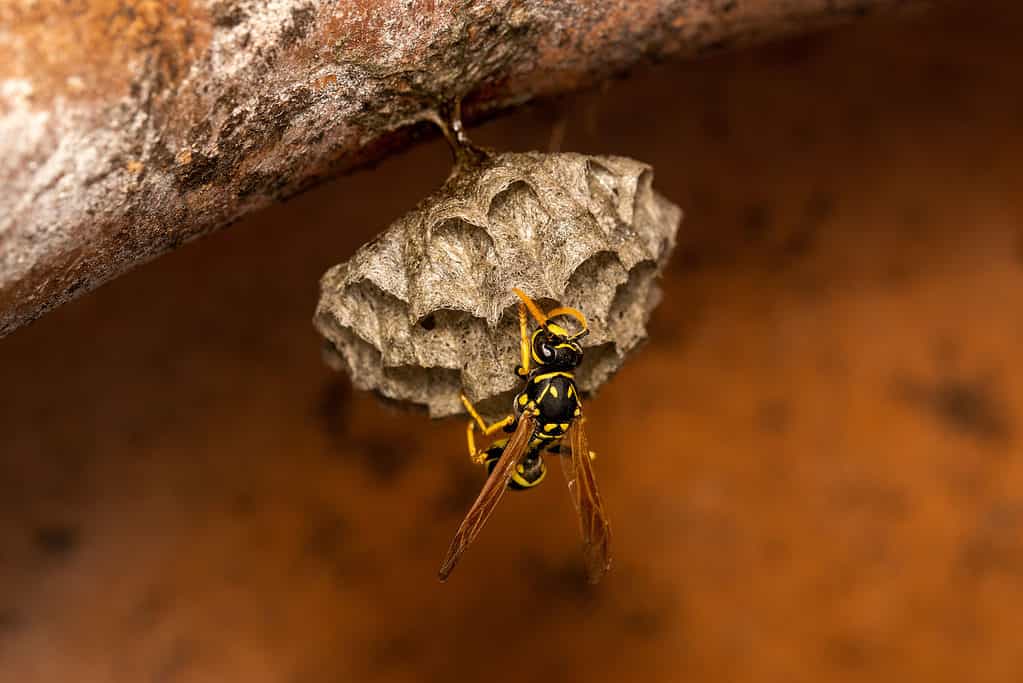
Using wood fiber gathered from plants, paper wasps create nests that resemble upside-down umbrellas.
©iStock.com/Wirestock
What Do Paper Wasps Eat?
The food of different kinds of wasps differs. The adult wasps dine on sugars from nectar, aphid honeydew, or a sweet liquid made by their larvae, while the larvae are typically fed fragments of insects that were killed and chopped up by the wasps. This type of wasp lives primarily on caterpillars!
Since the majority of wasp species are parasitic, they deposit their eggs within other insects, we humans are rarely bothered by them. Paper wasps that are gregarious and seek out human food are some of the ones that you encounter most frequently.
Even while paper wasps infrequently sting humans, they will do so if frightened or provoked. People frequently get stung when they stumble across paper wasp nests that are concealed in bushes or close to dwellings.
Paper wasps help ecosystems since they regulate insect populations, yet because of their potent sting, people are afraid of them. Due to this, when homeowners encounter wasps in their yard or home or discover a wasp nest, they become worried about wasp control. The best strategy to avoid paper wasps in the first place is to understand what they enjoy eating.
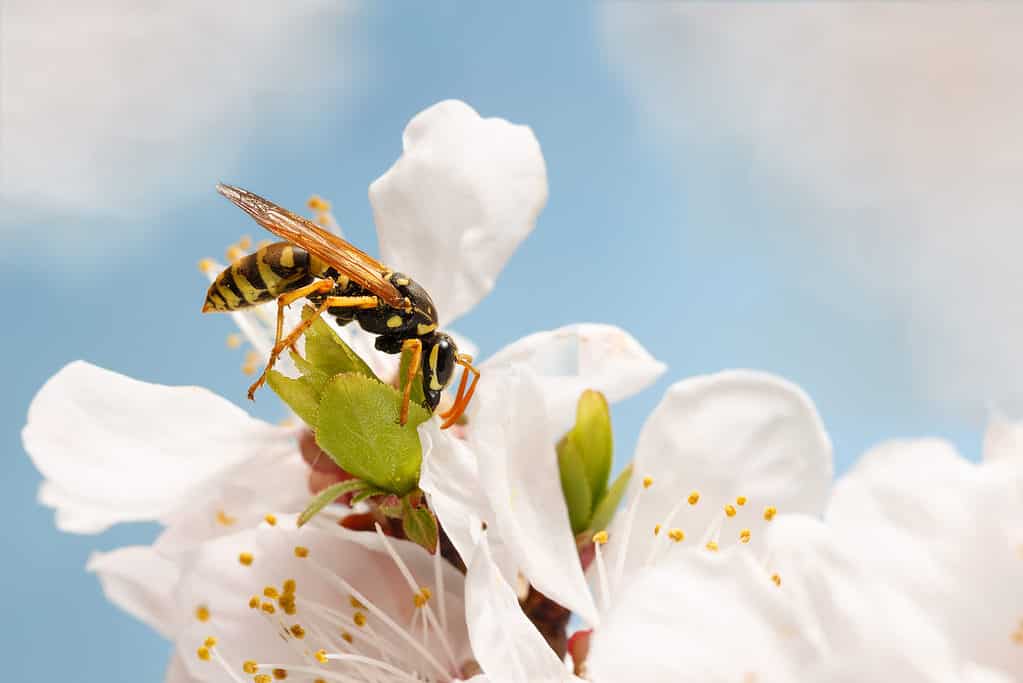
Adult paper wasps dine on sugars from nectar, aphid honeydew, or a sweet liquid made by their larvae.
©iStock.com/tenra
How to Identify Paper Wasps
At first appearance, it might be challenging for the typical person to distinguish between paper wasps and yellow jackets. Admittedly, these two wasp species resemble one another in appearance, having a similar pattern of black and yellow stripes. A closer inspection reveals some variances, though.
Paper wasps have a brown tint and typically have yellow markings, while red stripes are occasionally seen. They have large legs and antennae, and they range in length from 1/2 an inch to 3/4 of an inch.
Paper wasps have notably long legs that seem to hang carelessly when flying, and their waists are significantly slimmer than those of other species. The simplest technique to distinguish between the two species, given that wasps should be avoided due to their identical morphological characteristics, is to study their nests without going too close.
Paper wasp nests are inverted cone-shaped structures that are always constructed above ground, occasionally on the ledges of structures or in trees. They might be as small as a fist or as large as a basketball.
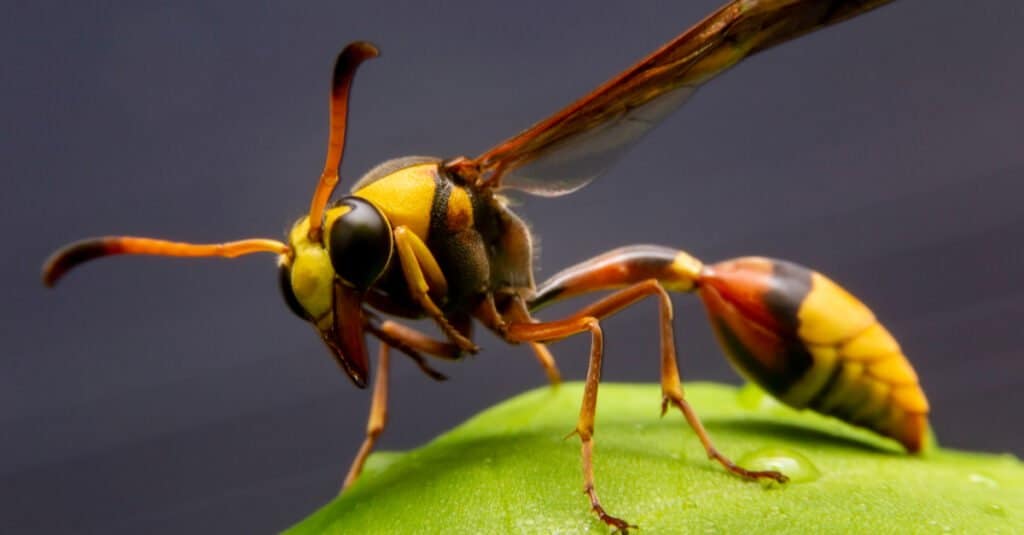
Paper wasps have notably long legs and their waists are significantly slimmer than those of other species.
©Witsawat.S/Shutterstock.com
Keeping Paper Wasps Away
Paper wasps can be a major problem, particularly in the summer. These gregarious insects start constructing their nests and laying their eggs in the spring. Destroying any wasp nest you come across is the best course of action to keep winged intruders from taking over your home.
Although they don’t want to sting people, they will go to any lengths to safeguard their nests. There are a handful of things you can try at home as a paper wasp repellent if you’re questioning how to prevent wasps from getting comfortable on your property in the first place.
Up Next
- Yellow Jacket vs. Paper Wasp: The 7 Key Differences
- Beehive Vs Wasp Nest
- 13 Animals That Sting (Ranked in Order of Most Painful)
The photo featured at the top of this post is © JorgeOrtiz_1976/Shutterstock.com
Thank you for reading! Have some feedback for us? Contact the AZ Animals editorial team.




